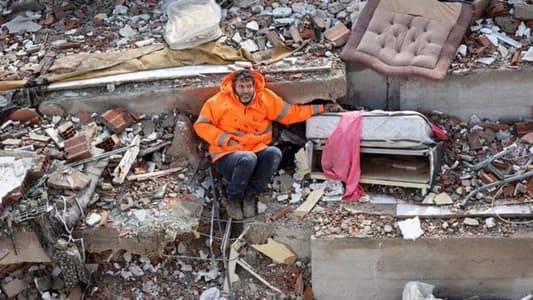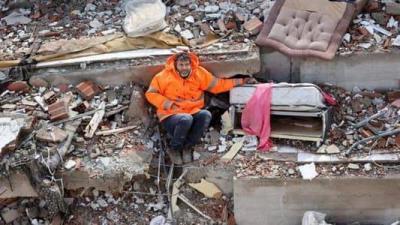The aftermath of disasters, whether humanitarian or natural, leaves behind psychological effects. Some are temporary and fade after a while, while others lead to chronic psychological disorders that require ongoing monitoring and treatment. Since the dawn of February 6, when the aftershocks of the Turkey-Syria earthquake awakened terrified Lebanese, many have reported an inability to sleep, an ongoing sensation of repeated tremors, and fear of sleeping away from their families or children. Some have even begun to describe themselves as needing sedatives. These negative thoughts reflect a decline in mood, sometimes accompanied by physical symptoms like nausea and cramps. This situation has been exacerbated by the trivialization of news coverage by some television stations, as well as social media platforms that propagate frightening news about impending destructive earthquakes.
Despite this, Dr. Layla Akouri Al-Dairani, the head of the Psychologists' Syndicate in Lebanon, believes that the Lebanese reaction to this natural disaster was "intense given the effect it had on Lebanon." She attributes this to the fact that "the psychological state of the Lebanese has been unstable even without an earthquake, having endured three tumultuous years on all levels, starting with the economic collapse in 2019, through the COVID-19 pandemic, the Beirut port explosion on August 4, and not to mention the suffocating daily life and general anxiety regarding the unknown, especially with the continuous rise of the dollar, placing them in front of a daunting question: How will they find medicine and food?"
All this anxiety drains the nerves, and when a disaster occurs, anxiety turns into panic, and the ability to control oneself diminishes. According to Al-Dairani, it is not possible to talk about a state of collective shock after this incident; "we are not discussing a post-traumatic stress disorder situation, but rather severe stress which is natural following a disaster." In this regard, she notes that "a person possesses the natural capacity to regain balance, each according to their proximity to the shock and their psychological resilience." Al-Dairani emphasizes the necessity of dealing with those who have experienced a strong trauma without excessive emotions, without blame or trivialization, but rather allowing them to rest and calm down.
She suggests giving individuals "one to three months for symptoms like: disturbance upon hearing any sound, disturbed sleep at night with nightmares, disrupted eating patterns, avoidance of movement and going out, or any psychological state that limits a person’s ability to carry out their daily life responsibilities, such as working, studying, taking care of oneself and others... But if strong symptoms persist beyond this duration, we then talk about a state of trauma that varies in degrees of intensity and severity, and it should be treated by a specialist." Al-Dairani also advises reducing exposure to television and social media, as "stepping away from news and images and discussing the situation while engaging in everyday life can help alleviate stress, especially in front of children."
What about children? Disasters affect children much more than adults, especially when they observe the reactions of adults—screaming, panic, and lack of emotional control. Natural disasters, like other life events such as death and accidents, occur and cannot be escaped from, and they are frightening and painful for both the young and the old. Since we cannot protect a child from these occurrences or shield them from the likelihood of future earthquakes or any natural disasters, "the only thing we can do is explain to the child what happened," particularly to those who woke up that fateful morning, experienced the terror, and were subjected to trauma, according to educational and social consultant Hana Fadlallah. She explains: "Initially, we can discuss our feelings in front of the child, but in a balanced way, and tell them that everyone can feel afraid, and we were scared too. We must explain that what happened was sudden and we were not prepared to react, so we had to secure our safety first, which is why we ran from the house. Moreover, we must allow the child to express their feelings and share their experiences, even if they repeat the details, as this is a form of release. We should embrace their emotions and affirm their right to feel afraid because we felt fear too."
According to Fadlallah, it is normal for some children who experienced trauma to struggle with sleep, fear of sounds, and eating issues, especially since they saw their parents frightened. "These effects can linger if not addressed in a positive way and treated." She points out the need to "reduce children's exposure to news without cutting them off completely from what is happening, as this is a form of negative protection, which may lead them to believe that things outside are dangerous and their parents do not want them to know, thus amplifying their fear." In her view, "protection from the news is external protection, but we should also focus on what is happening inside them, which is our responsibility. We protect them externally by limiting harmful information and exposure to distressing news and images, and once the initial shock has passed and the child has expressed their feelings and calmed down, we explain to them what happened." Fadlallah mentions the existence of videos for children that "simplify and clarify the practical aspects of what occurred, removing ambiguity and reducing fear, and we try to reassure them that if this were to happen again, we would be better prepared."




